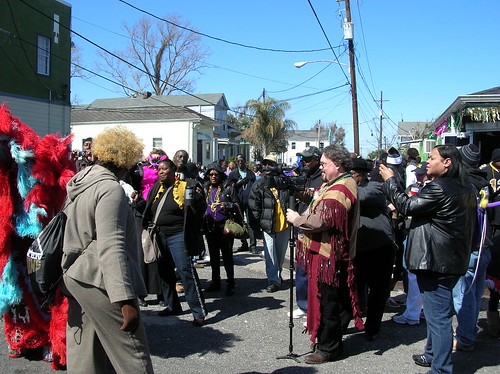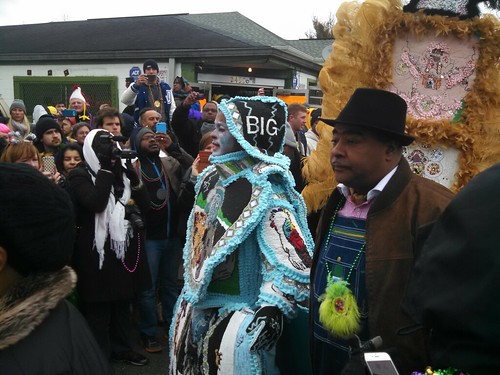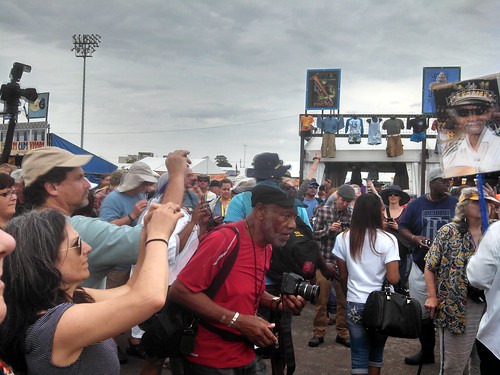Covering Super Sunday as a photographer has become increasingly challenging. With the Indians' immense popularity, crowds swarm the area with smartphones and iPad cameras, elbowing each other for a close up of the Indians' feathers and finery.I know what he's talking about. I go out to Second and Dryades every Mardi Gras morning and it can get kind of cramped with photographers.


Not that that's a huge problem in and of itself. We live in a time when almost everybody has some sort of camera on them practically all of the time and people like to document things they are seeing. That's fine. Still, there's something weird about it and people should be aware of how it looks. Here's a pack of photographers chasing after a second line tribute to Uncle Lionel Batiste during Jazzfest a few years ago.

Again, the issue here isn't really that everybody likes to photograph things. And it's not just that the crowds at Super Sunday are getting heavier, although they certainly are. It's more about the way these neighborhood celebrations have become prime attractions for a destructive sort of "authenticity tourism."
@skooks I was just talking about how I feel like I am being forced to participate as a background character for ppl LARPing that show— breonne (@prokchorp) March 19, 2017
We're used to there being a lot of activity in our area during second lines and stuff. But Sunday was different. This was out of state plates taking up all of the parking on the block indicating the short term rentals were full. This was sitting out on the stoop watching Uber drivers headed the wrong direction on one way streets. As I was carrying a sack of clothes into the laundromat, I had to step around a pack of visitors coming out of the Airbnb across from us. They were discussing, and I swear I am not making this up, which Treme character was their favorite. Next year I'm going to make a Bingo card to track this sort of thing. It's only likely to get worse.
The reasons it's going to get worse:
1) National publications for wealthy readers are still producing travel pieces about our "authenticity" product.
2) Nobody can afford to actually live in our "authenticity" themed neighborhoods anymore.
- 81% of Airbnb’s U.S. revenue – $4.6 billion – comes from whole-unit rentals (those rentals where the owner is not present during the time of the rental), rising from 78% in the prior year.
- Each of the 13 cities studied saw an increase in the total number of listings by multi-unit hosts. In Nashville, Seattle, Oahu, and New Orleans, the growth of the number of units managed by multi-unit operators more than doubled -- and Nashville saw an increase of more than 160%.
- The markets with the highest share of total revenue derived from multi-unit hosts are Miami (57.9%), Oahu (53.5%), and New Orleans (42.3%).
3) This is only going to exacerbate the already intolerable situation with housing costs in New Orleans.
At the start of March, New Orleans is still ranked No. 15 for the city with the most expensive rent in the United States.According to Zumper’s National Rent Index, the average price of one bedroom apartments in New Orleans is $1,142, and two bedroom units are an average $1,353. In considering March of 2016, rent has increased 15 percent from last year.
To understand the role of STRs here, take a look at this study of Airbnb's effects in New York. The authors examine the loss of available housing to STRs as well as a pronounced Airbnb "rent gap."
Here the relevant metrics are less about housing units and more about money—revenue flows through the urban housing market. As Neil Smith explained nearly forty years ago, gentrification is “a back to the city movement by capital, not people”.In terms of gentrification, Airbnb is perfect for New Orleans in that it is an anti-personnel weapon. It (mostly) leaves the scenery in place but clears out all the troublesome residents. This way the appearance of what was once a vibrant neighborhood is retained for the benefit of the temporary occupants to whom it is sold.
The existence of a rent gap means that, systematically across a neighbourhood, landowners can earn more money from some different use of their property than from the existing use, which creates an incentive to reinvestment and hence gentrification. As I discussed above, we normally think of rent gaps leading to new capital investment—renovations and redevelopments—but in the case of Airbnb this generally won’t be necessary. Property owners will just switch their units from residential leases to short-term rentals. So if there has been an Airbnb-induced rent gap, we shouldn’t expect to see big new capital expenditures; instead we should expect to see routine housing revenue flows (which are mostly composed of rent and mortgage payments) diverted into Airbnb.
I know I say this a lot but the STRs are completely taking over in Central City. It's made the scene during Mardi Gras a little more uncomfortable every year. Its effect is even worse during events like Super Sunday and the time around Jazzfest when the "authenticity" quotient is high. This month the city's registration program began officially and The Lens has begun mapping applicants. As of Monday, they've counted 294. But given, the 4,500 listings tracked by InsideAirbnb, we know there's a lot of space left to fill.
Unfortunately space is running out for those of us just trying to live in the city. Incidentally that includes the individuals who create and maintain the now hopelessly commodified cultural events and folkways that made our spaces attractive to authenticity tourists in the first place. It isn't hard to imagine a point when these celebrations lose their meaning entirely. If the traditional parade grounds of Indian gangs and Second Line organizations are no longer the places those people actually live, what is the point of even staging these events? What is a neighborhood parade without a neighborhood? What is a neighborhood without neighbors?
No comments:
Post a Comment